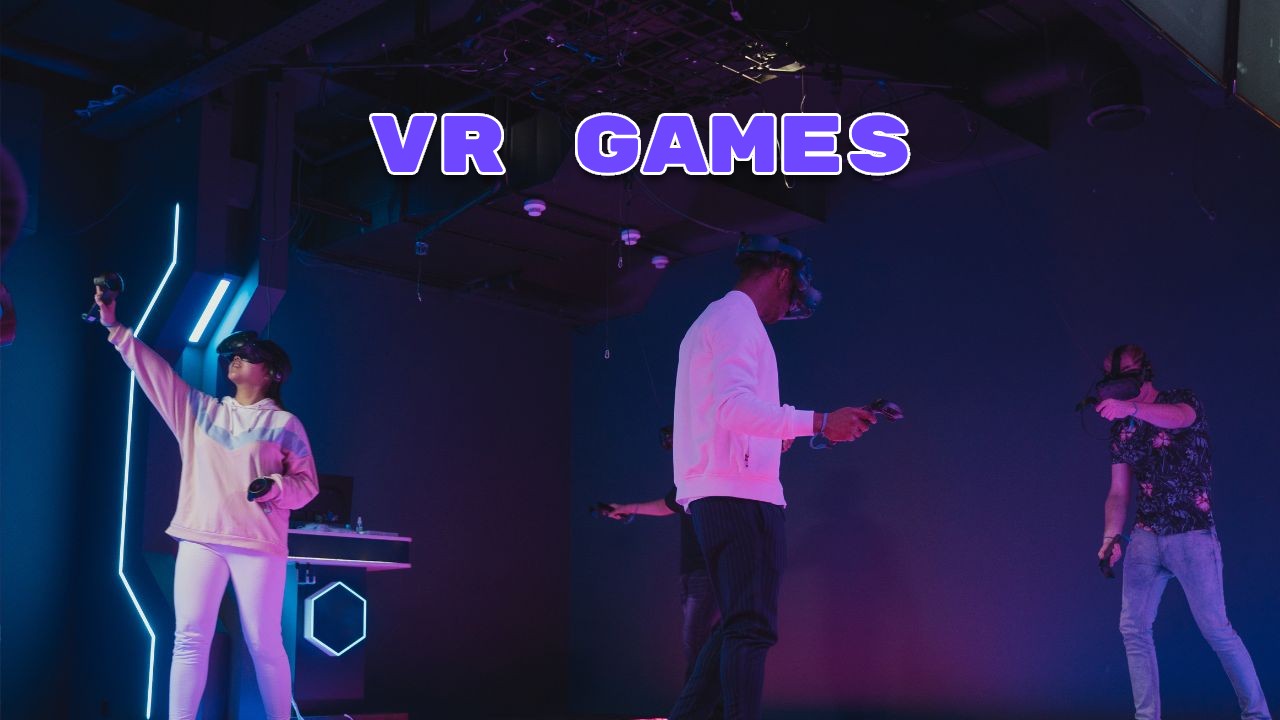In recent years, VR games have become more and more popular across a wide range of players, from casual to hardcore.
By making people immersed in the virtual world through VR headsets, controllers, and other technology, VR game developers have transformed the traditional gaming landscape into a new digital realm.
But what is the exact technology behind these games, and how do they navigate players through an immersive universe with extraordinary sensations?
Let’s learn more about how VR games can impact the way we play games!
The Essence of VR Gaming
VR games, or virtual reality games, are video games that take players into a whole new digital world, where every experience is realistic and immersive.
Instead of just standing in front of the screen and using a mouse, or keyboard to navigate throughout the game, players are now using VR gaming devices, such as headsets, controllers, or even guns, to interact with the game.
In other words, VR games are designed to create a virtual environment for players to interact and enhance the gaming experience to the next level through interactive technology.

What makes these games special, among others, is that they make players feel like they are really inside the game, with lifelike sound, movement, and realistic graphics.
What could be more fun than immersing yourself in another dimension that is right in front of you?
So, the realistic feeling the game brings, whether it’s excitement or pressure, makes you engaged in the game wholeheartedly to proceed continuously throughout the adventure.
Historical Perspective
We have to look back to the early days when the first virtual reality headset was created by Ivan Sutherland.
The early device, known as the “Sword of Damocles”, was connected to a computer and used mirrors to show 3D images in front of the user’s eyes. This early invention set the foundation for a lot of advancements later on.
Following that invention, several other virtual reality prototypes were developed but did not gain public recognition.
It was not until the 1990s, when a company called Virtuality released its first commercial VR headset to the market, that people widely accepted the concept of VR games.
During these early days, while the technology still had limitations, developers were still able to adapt players with their creativity.
For example, Dactyl Nightmare was created by Virtuality in 1991 to bring players a unique experience by using virtual reality headsets and handheld controllers to engage in a battle.

Virtual Boy by Nintendo in 1995 created a notable step in the evolution of virtual reality gaming as it was the first portable console with a 3D display for virtual reality gaming.
Similarly, Sega’s 1999 Dreamcast console featured a virtual reality accessory, the Sega VR, offering a glimpse into the potential of virtual reality technology.
During the 2000s, virtual reality gaming continued to develop as a niche market. However, in 2012, with the big success of the new headset Oculus Rift, this genre became more widely spread to various gamers.
This headset featured a high-resolution display, precise motion tracking sensors, and a comfortable design so players could wear it for extended periods.
That said, these significant milestones and technological breakthroughs marked the inception of virtual reality gaming. And this genre continues to evolve with a bigger fanbase.
The VR Gaming Experience
To help you enjoy the 3D world, VR platforms are necessary. To be more specific, they are systems using advanced computing and user-friendly interfaces to provide you with immersive experiences.
Some major VR platforms are Oculus (Meta), HTC Vive, and PlayStation VR.
These platforms often include screens, cameras, headsets, controllers, motion sensors, and associated software ecosystems to bring players the most realistic feeling and environment.

That said, VR platforms shape the overall gaming experience as they are the gateway for players to enter and interact with the virtual gaming world.
Now, as we’re looking at the VR gaming experience, we should highlight the role of Facebook’s Meta, the parent company of Oculus.
As a major player in the industry, Meta focuses on developing technologies, VR hardware, and software.
Notably, Meta’s Oculus headsets have gained popularity for their wireless, standalone design and powerful features that contribute to the development of the game genre.
Also, Meta fosters a sense of community within the virtual realm, where people can have fun and connect in a whole new way.
Popular VR Games and Genres
As VR gaming has developed constantly and appealed to many players joining the realm, there are various genres have arisen to tailor to different tastes, preferences, and interests.
Here are some notable video game genres and their best VR games.
First-Person Shooters (FPS)
As its name clearly defines, this game genre allows you to experience intense shooting scenarios from the first-person perspective.
These games often require you to react proactively in situations and to compete against each other in the same battlegrounds.

Featured game: Half-Life: Alyx
This game takes you into the Half-Life universe, where you can use weapons to combat and solve puzzles, all contribute to the immersive experience.
Action-Adventure
Action-adventure VR games combine two main elements: action and adventure.
While you explore virtual worlds, you also have to complete puzzles and join in battle to move forward. So, games in this genre often have compelling narratives to intrigue players for extended periods.

Featured game: The Elder Scrolls V: Skyrim VR
Immerse yourself in a vast world filled with dense forests and ancient ruins. You are taken into exciting explorations and encounters without boundaries; every step is full of fantasy and discovery.
Puzzle and Escape Rooms
These games challenge you to solve puzzles in a three-dimensional space. So, you should equip yourself with problem-solving skills and the ability to pay attention to details to untangle all the riddles and escape the room.

Featured game: Obduction
Obduction is like a giant escape room game with puzzles everywhere. Instead of escaping just a room, you’re trying to leave an entire planet to get back home.
This game might take longer to complete than other titles; some players said that it takes them around one and a half days to finish.
Horror
Games in this genre include terrifying experiences to scare every player when they join in. You’ll feel like you’re actually in a spooky place, with creepy things happening all around you.
Also, the nature of VR boosts the sense of fear and fright. So these games are only suitable for those who enjoy the scary and thrilling experience.

Featured game: Resident Evil VII
The game is set in a spooky mansion in Louisiana, and you have to solve puzzles and fight creepy monsters. You should prepare yourself while playing as the game focuses on a horror atmosphere and a gripping narrative.
The Technology Behind VR Games
Technology comes into play to bring the immersive experience to life by seamlessly integrating advanced hardware.
These include:
- Headsets: This is the gateway to engage in the virtual world. It tracks head movements and displays the illusion in front of the user’s eyes, making you feel like you are actually inside the virtual environment.
- Motion Tracking: This technology follows all your body’s movements so you can interact within the virtual environment. Whether you turn your head or take a step, it ensures your virtual surroundings react accordingly.
- 3D Engines: These are software frameworks that power VR games. Game developers use them to create the landscapes, objects, and everything you see in the game.
- Audio: This is the important part that completes your experience in the virtual world. Hearing high-quality audio from the right direction makes you feel like you are truly present in that landscape.

But the technology doesn’t stop there, as there are innovations and advancements that continue to enhance VR gaming to make it even more mind-blowing.
One notable recent advancement is the release of the HTC Vive wrist tracker. It lets you move your hands freely without losing accurate tracking. This means you can do more natural movements in VR, making the experience feel even more real and fun.
Moreover, we can expect a more immersive game publishing by looking at the Teslasuit. This full-body suit allows gamers to feel every haptic sensation and touch their skin to the fullest.
VR Gaming and Its Impact on Players
As players engage in the virtual worlds, they are about to immerse and interact with all virtual elements in a realistic manner.
Some researchers have found that the essence of how VR games work can affect players psychologically. They give players more of a feeling of presence in virtual landscapes.
As a result, this heightened sense of presence can evoke a range of emotions for players, both positive and negative, making the gaming experience more emotionally impactful.

On the good side, VR games can provide players with a sense of interaction and realism that is incredibly difficult to find in other traditional games.
In fact, some VR games can also used for people to experience real-world scenarios that they’ve never tried before, like medical students in surgery simulations.
On the negative side, spending too much time on VR gaming can lead to the symptoms of dizziness and headaches. Although these feelings are temporary, they somehow still impact the health of players as well as the enjoyment of the game.
Additionally, it is found that some players have feelings of anxiety and confusion when they are separated from the game.
So, it is necessary for players to capture all the impacts and adjust the time spent on VR games to enjoy the fullest experience.
The Future of VR Gaming
When we look ahead to the future of VR gaming, it appears to be promising and exciting at the same time.
It can be easily anticipated that technology will continue to evolve constantly, with numerous advancements and innovations coming into play.

Due to this, we can expect more improvement in resolution, graphics quality, and motion tracking. Also, new technologies will make the games feel even more real, thus elevating the immersive experience of players to a whole new level.
In the future, VR gaming can be expected to become an integral part of the gaming industry with various widespread titles.
AI in gaming will also be fully taken advantage of by video game publishers to provide a more engaging gaming experience to players.
By incorporating AI into VR games, the gaming industry opens the door to more personalized gameplays and responsive game worlds, where players can easily find games that best suit their styles and preferences.
Conclusion
VR Games have evolved into an incredibly immersive medium in our world of entertainment.
By incorporating cutting-edge technologies into games, we can find new ways to immerse ourselves in the sense of realism and interaction.
From the early days until today, VR games keep getting better. They offer us all kinds of games and experiences that are totally changing how we play and enjoy pleasure.
Looking ahead into the future of VR gaming, we can expect even more exciting changes. VR gaming will undoubtedly become a key player in shaping the next era of interactive experiences.
Loading survey...

